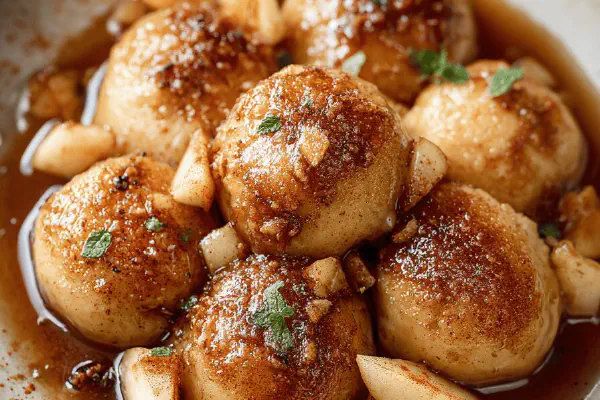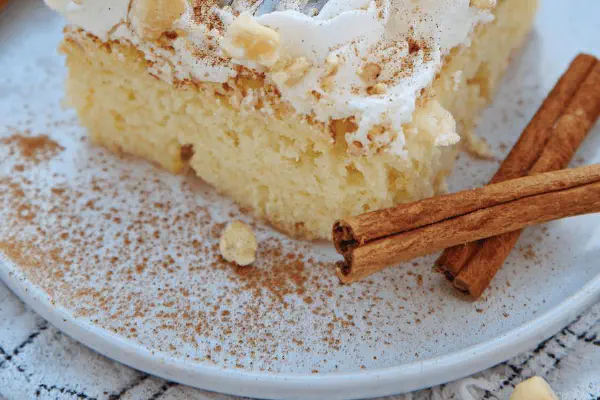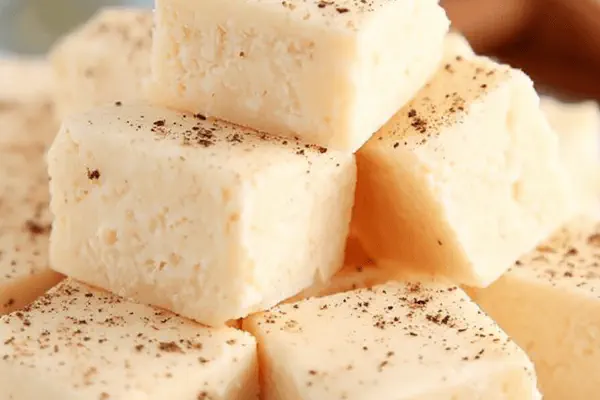Red Velvet Yule Log

By Emma
Certified Culinary Professional
Ingredients
Cakes
- 280 ml (1 1/8 cup) unbleached all-purpose flour
- 65 ml (4 1/2 tbsp) cocoa powder
- 3 ml (1/2 tsp) baking soda
- 6 large eggs
- 5 large egg yolks
- 250 ml (1 cup) granulated sugar
- 45 ml (3 tbsp) grapeseed oil
- 16 ml (1 tbsp + 1 tsp) liquid red food coloring
- 15 ml (3 tsp) white vinegar
- 5 ml (1 tsp) almond extract
Italian Meringue
- 80 ml (1/3 cup) water
- 150 ml (2/3 cup) light corn syrup
- 5 large egg whites
About the ingredients
Method
Cakes
- Start with oven rack centered. Heat to 175 °C (347 °F). Line two baking sheets with parchment paper; then grease well to avoid sticky, shredded cake skin later.
- Sift together flour, cocoa powder, baking soda – triple sifting keeps lumps out, textures even. Set aside.
- In sturdy bowl, whip whole eggs, yolks, and sugar at high speed. Watch closely. After 8-12 minutes, mixture should be pale, tripled, ribbon consistency when beaten falls off the whisk slowly, holds shape.
- Slowly drizzle grapeseed oil, then fold in red dye, vinegar, and almond extract – I swapped vanilla for almond to deepen aroma without extra liquid. Mix medium speed until uniform.
- Now, gently fold dry ingredients with a whisk; don't over-mix or will deflate. Fold just enough to see no flour streaks. Spread evenly onto sheets – spread edges thinner for uniform rising. Tap pan lightly to release air bubbles.
- Bake 14-17 minutes. Use visual and tactile cues; spring back slightly when touched, edges pull clean from sides, top set but still soft. Insert tester toothpick; crumbs but not wet batter means ready. Don't overbake or it cracks when rolling.
- Cool on racks 5 minutes. Flip cake out onto fresh parchment. Peel off the top paper immediately to prevent sogginess. Cover loosely with clean towel. Cool completely to touch. If cooled too long, cover lightly with damp tea towel to prevent drying.
Italian Meringue
- Combine water, corn syrup in saucepan. Heat over medium-high until candy thermometer reads 114 °C (237 °F) – watch carefully; dark amber tones signal caramelization starting; remove immediately to avoid hard crystallized syrup.
- While syrup heats, beat egg whites at low speed to soft peaks. When syrup hits temp, pour in slow steady stream into whites while beating high speed. Keep whisking 12-18 minutes till thick, shiny, forming peaks that stand tall like stiff mountains, with no stickiness.
- Test meringue by rubbing a bit between fingers; shouldn't feel grainy. If gritty, keep beating or start over. Use immediately as meringue deflates if left too long.
Assembly
- Trim odd edges of cakes. Remove top parchment from each cake piece gently; if stuck, moisten with water sprayed lightly, then peel.
- Lay cakes lengthwise, side by side, seam in middle. Spread 20% of meringue evenly over each sheet, thin layer – too thick, and the log will burst when rolled.
- Roll first cake tightly from short side, careful not to crack. Use parchment to help support the roll, moving slowly. Repeat with second cake, then nestle the second roll onto the first to create a large log.
- Transfer log carefully onto serving plate with two spatulas, no sudden moves.
- Smother remaining meringue around the log’s surface in thick coat, using spatula or palette knife to create bark-like ridges and texture.
- Leave uncovered at room temperature up to 4 hours to firm up meringue. Don't refrigerate or the sugar may dissolve, meringue weeps.
- Serve same day for best texture. Use a serrated knife wiped clean after each cut to preserve layers.
- If meringue begins to weep, fluff with electric mixer briefly before serving.
Substitutions and Tips
- Grapeseed oil can swap for light olive oil; avocado oil also works but watch flavor neutrality.
- Almond extract swap: pure vanilla or a touch of orange blossom water for different aromatic kick.
- If red food coloring unavailable liquid beet juice (concentrated) or gel dye can be used; adjust quantity to avoid soggy cake.
- For non-Italian meringue method – Swiss meringue can substitute but Italian's heat-treated syrup gives better stability for spreading and holding shape.
- If eggs at room temp, beat faster to reach ribbon stage quickly; cold eggs slow and yield less volume.
- Freezing cake layers before rolling can help reduce cracking but hard to beat freshness and flexibility of just-cooled sponge.
- Humidity shifts the meringue time needed; stale, dry days speed drying out – adjust beating and storage accordingly.
Cooking tips
Chef's notes
- 💡 Sift all dry ingredients thrice. Lumps wreck delicate sponge feel. Cocoa powder especially tricky – uneven mixing leads to streaks or dry spots. Folding dry mix last, gently, prevent deflating air bubbles whipped in eggs; fold just to hide flour.
- 💡 Oil goes slow drizzle style. Grapeseed replaces canola for lighter crumb. Add oils, vinegar, and almond extract in one step to avoid multiple foldings. Almond extract stronger than vanilla so don’t overdose, impacts aroma without wetting batter much.
- 💡 Baking time is elastic. Use finger touch, edges pulling from parchment, toothpick inserted with moist crumbs, no raw batter adherence. Underbaking = soggy, overshoot = cracking when rolling. Flip out promptly post-bake. Peel parchment immediately or surface traps steam and sogginess creeps in.
- 💡 Meringue needs heat precision. Shrug off guesses, thermometer set to 114 °C (237 °F) for syrup. Too low = weak peaks, too high = crystallized sticky mess. Beat whites to soft peaks before pouring syrup slowly. Beat 12–18 mins post-syrup until glossy stiff peaks sit tall but not dry.
- 💡 Roll cakes while slightly warm, not hot, or cracks snap. Thin meringue layer spread first over cake, around 20%, keeps roll flexible. Rolling two thin cakes side by side avoids giant crack risk and ups log volume. Use parchment to guide roll tight but move slow, steady. Finish with thick meringue coat textured with spatula – no fridge, room temp 4 hours to firm, else sugar dissolves and meringue sweats.
Common questions
How do I prevent cracks when rolling?
Roll warm but not hot. Spread meringue thin so it flexes. Use parchment to support roll. Two thin cakes better – side by side reduces stress. Moisture key; peel parchment quickly after baking to avoid sogginess breaking surface.
Can I substitute almond extract?
Vanilla or orange blossom water work but alter flavor profile. Vanilla makes milder aroma; orange blossom gives floral edge but test quantity. Different extracts change wetness slightly, add carefully to avoid deflating mix.
What if my meringue weeps?
Happens if chilled or stored too long. Keep at room temp covered loosely. If wet beads form, fluff with electric mixer briefly to restore texture. Avoid refrigeration—moisture dissolves sugar crystals causing sweat. Timing serving crucial.
How to store leftover log?
Wrap loosely at room temp for up to 4 hours. Longer needs careful cover to avoid dry meringue crust forming. Refrigeration discouraged; cold breaks meringue texture and causes liquid seams. If stuck, brief mixer fluff before serving refreshes appearance.



